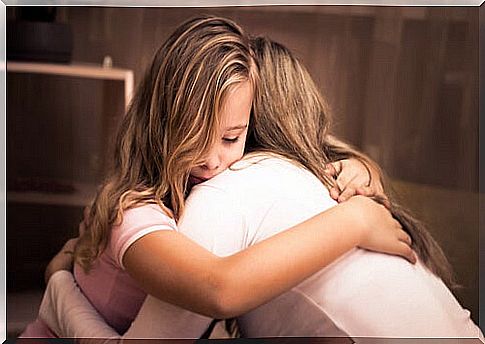Grief In Childhood: A Process That Needs Understanding

Children are the great forgotten when it comes to talking about grief. Child grief involves losses. As adults we have to help express the emotions of the children who suffer them and the truth is that sometimes we are not prepared to accompany them in this process. Thus, in this article we are going to learn strategies to accompany the grief of the little ones.
Fortunately, most children resolve their grief without major complications. But, for this reason it is no less important to know different strategies to help them, thus understanding a little more the process of childhood grief. In addition, how we go through the suffering of losing someone will determine the process of the children around us.
Child mourning
Most of the time we associate grief with death. But the process includes other losses: loss of a job, loss of a loved one, of a pet, loss of a relationship…. Grief is the emotional adjustment process that follows any loss. Without a doubt, it is the death of a loved one or a relative, the most difficult situation that we have to accept. Our ability to adapt to the new situation, our resilience, will depend on whether we live it in one way or another.
The death of a loved one causes pain, sadness, emptiness, loneliness … and all these emotions have to arise in order to be managed. The children also feel these emotions.
Children react to loss. And they do it in different ways. Depending on the evolutionary moment, how they receive the news, the reaction of adults, and their own experiences. As adults we have very little preparation to develop a grief, because we do not usually talk about death or terminal illnesses. Neither of the abandonments or the separation of the parents.
But we can learn new strategies. Let’s see some.
Accept the reality of loss
Accompany the child in the absence of that person. When someone dies, there is a feeling of emptiness. It is necessary to face that that person is no longer, and that he will not return. The child must also assume that he will never see him again. And for that he needs the adult to also go through that acceptance.
Manage emotions including pain
Emotions such as sadness, depression, feeling of emptiness, etc. They are normal. Feel pain, even physical, too. The child will have to feel those emotions. And accept them. This pain must be lived, not denied or repressed, because if this task is not completed it can lead to depressions where therapy will be necessary.
Adapt to an environment in which the deceased is absent
Start living without him or her, with that emptiness. Adopting their roles is a change. For children too. For example, keeping the household bills like Mom did is difficult. In short, it implies a change in circumstances and a redefinition of roles to continue growing and not remain stagnant.
Adapt emotionally to the deceased and continue living
Memories of a loved one are never lost. The deceased cannot be renounced, but rather find a suitable place for him in our hearts, so that we can look back and talk about him without suffering. The child will not forget the deceased, and will be able to look forward just like the others, with its emptiness.

There are behaviors of children in a grieving process that we can consider normal and not worrisome. Sleep disturbances, intestinal problems, regression to previous stages (thumb sucking, peeing), feelings of guilt, periods of intense emotions: anxiety, sadness, anguish, fears …
But there are other behaviors that are red flags. Excessive fear of being left alone, that he excessively imitates the deceased, that he moves away from his friends, that he does not play, that his school performance decreases, that he has behavior problems or that he runs away from home … these are behaviors that cause the suffering is excessive .
Stories to accompany the children’s mourning
Talking about the death of someone close is difficult. Feelings and emotions emerge that sometimes prevent us from putting words to the situation. But it is necessary to express our emotions, and it is easier with stories. Adults can find with Jorge Bucay stories to accompany losses and readings to channel our emotions.
Stories to address the theme of death with children are very useful for parents and professionals to help children understand and adapt to the new situation. Here are some of them.
I will always love you, little one . Aimed at the little ones, it talks about the unconditional love between a mother and her child. In addition to raising an issue as important as the durability and consistency of love, Debi Gliori addresses the issue of death.
Edu, the Wolf . Edu’s uncle, a small wolf, dies in an accident when they go hunting. In the midst of this trance, Edu will find a bunny who will help him bury it. The story speaks naturally about death and gives importance to friendship in difficult times.
Depending on the child’s age, we can spend more time with him, encourage him to express his emotions, share ours with him, correct inappropriate behaviors, involve him in family activities, calm his fears … If the symptoms persist or we do not know what to do, always we can ask a child psychologist for help. In fact, it is the most advisable when the duel is complicated.









